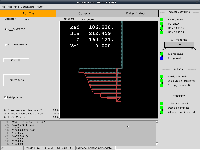G Code Generation for Camshaft grinding
- andypugh
-

- Offline
- Moderator
-

Less
More
- Posts: 19752
- Thank you received: 4584
27 Jul 2017 09:24 #96541
by andypugh
No, I would expect worse performance with a rotary axis as the path-blending in angular-linear moves uses a single segment lookahead whilst linear-linear uses a many-segment lookahead.
Do you know if your axis acceleration limits programmed for the axes are anywhere near the physical/mechanical limits?
Replied by andypugh on topic G Code Generation for Camshaft grinding
Currently I'm configured two linear axes. Do you expect any better performance if the rotary axis is configured as a rotary axis?
No, I would expect worse performance with a rotary axis as the path-blending in angular-linear moves uses a single segment lookahead whilst linear-linear uses a many-segment lookahead.
Do you know if your axis acceleration limits programmed for the axes are anywhere near the physical/mechanical limits?
Please Log in or Create an account to join the conversation.
- TobiasKa
- Offline
- New Member
-

Less
More
- Posts: 7
- Thank you received: 0
27 Jul 2017 11:17 #96547
by TobiasKa
Replied by TobiasKa on topic G Code Generation for Camshaft grinding
Ok, so I will stay with the "double linear" configuration.
I tried several acceleration values for the linear axis.
There I have not seen any improvement nor deterioration.
I have looked through the documentation, but I have not found any detailed information how the acceleration values are taken into account during a synchronized G01 movement.
Anyway I have just wrote down how I calculated the desired velocity of the system:
Maybe someone can point out where the flaw is in the calculation process?
I tried several acceleration values for the linear axis.
There I have not seen any improvement nor deterioration.
I have looked through the documentation, but I have not found any detailed information how the acceleration values are taken into account during a synchronized G01 movement.
Anyway I have just wrote down how I calculated the desired velocity of the system:
Maybe someone can point out where the flaw is in the calculation process?
Please Log in or Create an account to join the conversation.
- massimodamassa
-

- Offline
- Senior Member
-

Less
More
- Posts: 45
- Thank you received: 9
27 Jul 2017 11:52 - 27 Jul 2017 11:54 #96551
by massimodamassa
Replied by massimodamassa on topic G Code Generation for Camshaft grinding
Try putting G61 at startup linuxcnc.org/docs/2.7/html/gcode/g-code.html#gcode:g61-g61.1
Last edit: 27 Jul 2017 11:54 by massimodamassa.
Please Log in or Create an account to join the conversation.
- andypugh
-

- Offline
- Moderator
-

Less
More
- Posts: 19752
- Thank you received: 4584
27 Jul 2017 12:21 #96553
by andypugh
I don't think that there is anything wrong with the calculation, but I am unsure why you are doing it.
The INI file limits should match the machine capability, not be based on the desired speed. They are limits.
Replied by andypugh on topic G Code Generation for Camshaft grinding
Anyway I have just wrote down how I calculated the desired velocity of the system:
Maybe someone can point out where the flaw is in the calculation process?
I don't think that there is anything wrong with the calculation, but I am unsure why you are doing it.
The INI file limits should match the machine capability, not be based on the desired speed. They are limits.
Please Log in or Create an account to join the conversation.
- andypugh
-

- Offline
- Moderator
-

Less
More
- Posts: 19752
- Thank you received: 4584
27 Jul 2017 12:23 - 27 Jul 2017 12:25 #96555
by andypugh
Replied by andypugh on topic G Code Generation for Camshaft grinding
This might be useful reading:
linuxcnc.org/docs/2.7/html/user/user-con...#_trajectory_control
Note that in this context the "naive cam detector" is detecting G-code from naive CAM software (lots of short straight moves) and has nothing to do with mechanical cams.
linuxcnc.org/docs/2.7/html/user/user-con...#_trajectory_control
Note that in this context the "naive cam detector" is detecting G-code from naive CAM software (lots of short straight moves) and has nothing to do with mechanical cams.
Last edit: 27 Jul 2017 12:25 by andypugh.
Please Log in or Create an account to join the conversation.
Time to create page: 0.089 seconds

